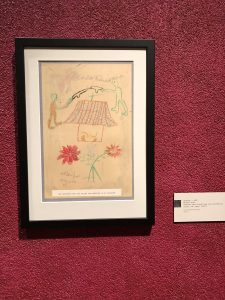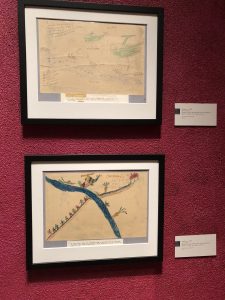Traditional art and contemporary politics collide within the “Arts of Resistance: Politics and the Past in Latin America” exhibit at the University of British Columbia’s Museum of Anthropology.
Despite the exhibit being filled with complexity in both content and artistic mediums, I found myself gravitating toward a threesome of crayon drawings. The collection was entitled “In Search of Safety,” containing three illustrations done by Salvadoran refugee children in the 1980’s. At this time, the Salvadoran military had used bombings, howitzer attacks and mortars to attack suspected communists, resulting in the death and evacuation of many civilians.
But why these drawings? What is it about the simplicity of a childhood narrative that make them so enticing? In this blog post, I will explore childhood trauma narratives and their impact on both the child and the world.

A drawing done by Maribel Ayala containing the words, “The soldiers came and killed our families in El Salvador.” Source: Ayala, Maribel. Arts of Resistance: Politics and the Past in Latin America. 17 May- 30 Sept. 2018. Museum of Anthropology at UBC.

A drawing (top) by Nora Alfaro states “When we were crossing the Lempa for a safe place in Honduras, helicopters were shooting on us, and they killed our relatives.” A drawing (bottom) by Luis Leiba says, “In the Lempa river the soldiers made a massacre and killed many children, old people and women. They burned the places where we used to live.” Source: Arts of Resistance: Politics and the Past in Latin America. 17 May- 30 Sept. 2018. Museum of Anthropology at UBC.
The Child
The Medical University of South Carolina defines a trauma narrative as the retelling of a child’s traumatic experience. The intentions of creating a trauma narrative are so the child can privately come to understand and express their experiences in a healthy manner. Through difficult and intense thought, the children relive and communicate their experiences in great detail. As seen in the “In Search of Safety” collection, one of the narrative mediums is drawing. The first image shows soldiers with guns coming to attack the child’s home, while the other two depict the helicopters that came and bombed them. The personal connection was then made through the words they chose to accompany the images. Blunt statements such as “they killed our families” allow the child to come to terms with what they have witnessed.
The World
Given previous acknowledgements to the privacy of trauma narratives, it is then interesting to see how their emergence into the public eye has made such a large impression. The simple and direct delivery in the narratives has crafted a raw connection between the survivors and their audience. There is a reason, for example, that Anne Frank’s, “The Diary of a Young Girl” is one of the most well known pieces to emerge from the second World War. By witnessing trauma through a child’s perspective, an undeniably cruel reality is presented which people can no longer feign ignorance to. The drawings in the exhibit, for example, are not necessarily art masterpieces, but they communicate complexity in an implicit manner. In other words, the art is able to juxtapose the innocent and simple mind of a child with the tragedy of war and violence. Perhaps they would not be found in a traditional art museum, yet they are a critical part of telling the story of Latin American politics. When it comes to violence, it appears that the world is more affected when children are involved.
And Finally, Me
The voice of a child is, in theory, the voice of innocence. Yet, standing in the “Arts of Resistance” exhibit, I came to realize how untrue that idea was. Children who experience trauma, whether that be due to political unrest or individual experiences, are no longer innocent. When I think back to my own childhood drawings, they contained things like a snowstorm or a sunny day; things that I observed in my everyday life. How horrible to think, then, that the depicted images of murder and violence are what their early memories consist of. The publications of childhood trauma narratives are important because they create awareness in a way that is impossible to ignore.
Works Cited
Arts of Resistance: Politics and the Past in Latin America. 17 May- 30 Sept. 2018. Museum of Anthropology at UBC.
Medical University of South Carolina. What is a Trauma Narrative? Bridges of Courage Counseling, 2018. www.thechildcenter.com/wp-content/uploads
Frank, Anne. The Diary of a Young Girl. Bantam, July 1993.